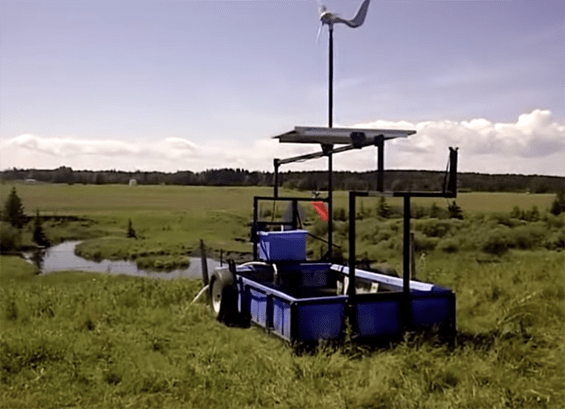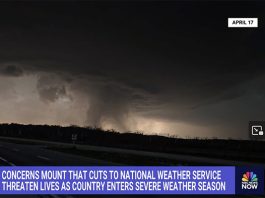Getting water to the herd can be one of the most challenging parts of a grazing system. Without water, weight gain takes a dive, or pastures become unusable. On the other hand, those luck enough to have a pond, stream or river in pasture face another challenge: using that water source without harming it. That’s where this watering system comes in.
Looking closely you’ll see that it’s basically a water trough on wheels. Thanks to long hoses and cords, it’s possible to pump water up to 200 horizontal feet away from the water source. That means no more erosion on banks and reduced sediment, manure and the potential for harmful algae blooms.
What I like best about this system is that it’s a demonstration unit. The Red Deer County Ag Services department took the initiative to develop this system and then loan it to graziers so they could test it out. When they learned how easy it was to protect their riparian corridors and still water their stock, they purchased their own set ups modified to fit their needs. I think this is a great idea and one that other areas could benefit from too. Consider talking to your local NRCS office or Conservation District about this idea. It’s a great way for graziers to test something out without risk, and is a good way to convince graziers to change their management.
For those who don’t love videos, I’ve transcribed the video below. I hope it gives you some good ideas for management that protects your fragile riparian zones. Enjoy!
Narrator:
In 2011, Red Deer County Ag Services replaced it’s off site watering demonstration unit. We’ve had 8 or 9 grazing seasons of use out of the old system and around 40 producers got to try it.
This year we figured it was time to take off-site watering to new heights and we’d need new equipment to do it. The new system is run by two 12-volt batteries. These batteries are charged by both a solar panel and a windmill, or by one or the other depending on the weather. This increased chargeability means increased flexibility for our farmers and ranchers wanting to try the system out.
 Another great feature with the new system is that the same pump can be used to pump from surface water, like dugouts or rivers, and it can pump from a well. Once again, this means more options for off-site watering locations. The system is also extremely portable. To move the water to a new location, just empty the trough, lower the windmill, get the wheels underneath, bring in the pump and hook up. Once you know what you’re doing, I think you could be moving down the road within an hour of pulling the plug. And within and hour of arriving at your new location, you could be pumping water again.
Another great feature with the new system is that the same pump can be used to pump from surface water, like dugouts or rivers, and it can pump from a well. Once again, this means more options for off-site watering locations. The system is also extremely portable. To move the water to a new location, just empty the trough, lower the windmill, get the wheels underneath, bring in the pump and hook up. Once you know what you’re doing, I think you could be moving down the road within an hour of pulling the plug. And within and hour of arriving at your new location, you could be pumping water again.
Like I said before, we wanted to take off-site watering to new heights. Quite often you see off-site watering systems parked pretty close to the watering source. This can create sediment, and worse, manure problems for the water source. Put another way, you can create the exact problem you’re trying to fix if you choose the wrong location for your off-site waterer.
Our new off-site watering system can lift water up to 60 feet vertically. Generally speaking, these days, lift capability of pumps is limited only by your budget. At the same time, the horizontal distance that a system can move water, is limited by the length of the water line, and by the load limits of the electrical lines running to the pump. So horizontal distance too is only limited by budget. Our new demo system is equipped to move water 200 feet horizontally.
The way things turned out this year, we had the unique opportunity to show the impact cows can have on a watering site. In a wet year like this year, it was particularly obvious. This is Tom and Jeanette Housman’s place on the north Raven River. Cattle have historically drank water directly from the river at this site. The Housman’s wanted to change this, so they booked our new demo unit.
 When we first got the waterer we only had 100 feet of line to work with. So we had to set the system up pretty close to the river. This was on June 6th. Fifty cow calf pairs started using the system shortly after. On July 22nd, seven very rainy weeks later, we finally got in to add another 100 feet of water line and electrical line. We couldn’t move the system though because it was too wet.
When we first got the waterer we only had 100 feet of line to work with. So we had to set the system up pretty close to the river. This was on June 6th. Fifty cow calf pairs started using the system shortly after. On July 22nd, seven very rainy weeks later, we finally got in to add another 100 feet of water line and electrical line. We couldn’t move the system though because it was too wet.
You can see the impact that the cows had on the vegetation, both on the hill coming down to the watering system and on the flood plain around the water trough. You can imagine the impact they would have had no the river bank had the waterer not been there.
 Finally on July 28th, it dried up enough we could move the waterer up, up, and away out of the riparian area and out of the flood plain. Now the cows didn’t have to go down the slippery hill anymore and the impact of 400 hooves around the trough was almost 200 horizontal feet away from the river. Any sediment and manure that leaves the trough area and flows down hill, now can be trapped and used by the hillside vegetation long before it reaches the river.
Finally on July 28th, it dried up enough we could move the waterer up, up, and away out of the riparian area and out of the flood plain. Now the cows didn’t have to go down the slippery hill anymore and the impact of 400 hooves around the trough was almost 200 horizontal feet away from the river. Any sediment and manure that leaves the trough area and flows down hill, now can be trapped and used by the hillside vegetation long before it reaches the river.
After seeing how good an offsite watering system could be by testing out the county’s demonstration unit, Tom decided to purchase his own watering system. He went with a similar unit, the difference being, he went with more solar panels and no windmill. Also the Housman’s have decided to permanently fence out the riparian area through their property. The river winds through their land, which is two quarter sections of North Raven watershed. Since they decided to build their fences well away from the river banks, Tom will be able to manage the river and riparian area as a special management unit in his livestock grazing operation.
Over the years, the Housmans have done a great job looking after their riparian area. You can see the results of their management when you see the diversity of plants that live there today. Riparian health assessment results are very positive. The management additions they’ve made with the fencing and the off-river watering system will result in even greater improvements.
Was the Demo Unit Successful?
Ken Lewis, who headed up this project, said that they sold the demo unit because it was no longer in demand by local ranchers. They had all purchased their own units and were moving ahead with projects to conserve and protect their riparian areas. Red Deer County has now created another innovative program that helps farmers and ranchers produce increased ecosystem services on their farms/ranches. The program assists ranchers by 1) cost-sharing with them on establishment costs for things like alternative watering systems (like the one in the video); and 2) making annual payments to them for their ongoing management that produces increased ecosystem services.
Wondering where you can get one?
The unit shown in the video was built by Sundog solar. I also spent a lot of time searching and making phone calls that led me to CAP Solar in Olds, Alberta, Canada.

They also produce a very interesting winter waterer that is both solar and propane powered. You can see it here. For our Canadian readers and those living near our northern neighbors, here’s a list of their dealers.
If working with a Canadian dealer isn’t for you, consider this demonstration unit as inspiration for working locally to create something that will work for you. That’s one of the things I love most about graziers – their ingenuity.
I’ll continue to look for more resources like this. In the meantime, if you have ideas or suggestions to share with your fellow graziers, please do!





Thanks Kathy.
I would remind readers in the USA that there are some fabulous opportunities to protect riparian areas through an NRCS program called CREP: Conservation Reserve Enhancement Program.
CREP is a trade-off of sorts for land-owner ranchers, but it’s a very good deal, in my humble opinion. We have given up nearly all of our riparian zones for wildlife and water quality, but the program has paid 100% of the fencing, water and forestry costs. Plus, we receive a modest annual rental payment for every acre that is protected. Our buffer zones are teaming with wildlife and native plants. We have recently embarked on our final CREP project and I am thrilled to be taking care of our land and water resources. CREP projects now represent the backbone of the infrastructure on our ranches. Getting the cows out of the creek is simply the right and smart thing to do.
Comments are closed.